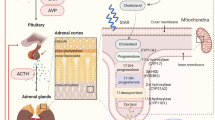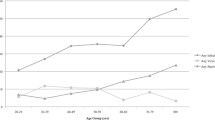Abstract
Rationale
Cholesteryl ester deficiency which results in adrenal lipid store depletion has been proposed as a potential mechanism of sepsis associated adrenal insufficiency.
Objective
We investigated histological abnormalities associated with sepsis in human and mice adrenals.
Methods
From January 2006 to 2008, seven patients who died of septic shock and seven patients with rapidly fatal nonseptic illness were included. Adrenals were sampled within 12 h from death. Adrenals were also taken from 13 lipopolysaccharide (LPS)-challenged mice, 5 cecal ligation and puncture (CLP) mice and 5 controls. We semi-quantitatively analysed intensity of inflammation, necrosis, haemorrhage and lipid depletion.
Measurements and main results
In patients, lipid depletion scores were significantly higher in septic shock than in controls (p = 0.011). In animals, lipid depletion was higher following LPS or CLP than in controls (p = 0.003). In adrenal cortex, in patients and not in animals, global scores for inflammation (p = 0.002), necrosis (p = 0.009) and haemorrhage (p = 0.009) were significantly higher in septic shock than in controls. Similarly, in zona fasciculata, in patients and not in animals, scores for inflammation (p = 0.007), necrosis (p = 0.023) and haemorrhage (p = 0.023) were significantly higher in septic shock than in controls.
Conclusions
This study shows that diffuse lipid depletion in zona fasciculata is a hallmark of human septic shock, experimental endotoxaemia and sepsis. In patients, sepsis was associated with inflammation, necrosis and haemorrhage predominantly in zona fasciculata.


Similar content being viewed by others
References
Polito A, Aboab J, Annane D (2007) The hypothalamic pituitary adrenal axis in sepsis. Novartis Found Symp 280:182–199
Marik PE, Pastores SM, Annane D, Meduri GU, Sprung CL, Arlt W, Keh D, Briegel J, Beishuizen A, Dimopoulou I, Tsagarakis S, Singer M, Chrousos GP, Zaloga G, Bokhari F, Vogeser M, American College of Critical Care Medicine (2008) Recommendations for the diagnosis and management of corticosteroid insufficiency in critically ill adult patients: consensus statements from an international task force by the American College of Critical Care Medicine. Crit Care Med 36:1937–1949
Annane D, Maxime V, Ibrahim F, Alvarez JC, Abe E, Boudou P (2003) Diagnosis of adrenal insufficiency in severe sepsis and septic shock. Am J Respir Crit Care Med 174:1319–1326
Prigent H, Maxime V, Annane D (2004) Science review: mechanisms of impaired adrenal function in sepsis and molecular actions of glucocorticoids. Crit Care 8:243–252
Mason JI, Rainey WE (1987) Steroidogenesis in the human fetal adrenal: a role for cholesterol synthesized de novo. J Clin Endocrinol Metab 64:140–147
Borkowski A, Delcroix C, Levin S (1972) Metabolism of adrenal cholesterol in man. I. In vivo studies. J Clin Invest 51:1664–1678
Borkowski A, Delcroix C, Levin S (1972) Metabolism of adrenal cholesterol in man. II. In vitro studies including a comparison of adrenal cholesterol synthesis with the synthesis of the clucocorticosteroid hormones. J Clin Invest 51:1679–1687
van Leeuwen HJ, Heezius EC, Dallinga GM, van Strijp JA, Verhoef J, van Kessel KP (2003) Lipoprotein metabolism in patients with severe sepsis. Crit Care Med 31:1359–1366
Temel RE, Trigatti B, DeMattos RB, Azhar S, Krieger M, Williams DL (1997) Scavenger receptor class B, type I (SR-BI) is the major route for the delivery of high density lipoprotein cholesterol to the steroidogenic pathway in cultured mouse adrenocortical cells. Proc Natl Acad Sci USA 94:13600–13605
Cai L, Ji A, de Beer FC, Tannock LR, van der Westhuyzen DR (2008) SR-BI protects against endotoxemia in mice through its roles in glucocorticoid production and hepatic clearance. J Clin Invest 118:364–375
Hoekstra M, Meurs I, Koenders M, Out R, Hildebrand RB, Kruijt JK, Van Eck M, Van Berkel TJ (2008) Absence of HDL cholesteryl ester uptake in mice via SR-BI impairs an adequate adrenal glucocorticoid-mediated stress response to fasting. J Lipid Res 49:738–745
American College of Chest Physicians/Society of Critical Care Medicine (1992) Consensus Conference: definitions for sepsis and multiple organ failure, and guidelines for the use of innovative therapies in sepsis. Crit Care Med 20:864–874
Wichterman KA, Baue AE, Chaudry IH (1980) Sepsis and septic shock—a review of laboratory models and a proposal. J Surg Res 29:189–201
Le Gall JR, Lemeshow S, Saulnier F (1993) A new simplified acute physiology score (SAPSII) based on a European/North American multicenter study. JAMA 270:2957–2963
Vincent JL, Moreno R, Takala J, Willatts S, De Mendonça A, Bruining H, Reinhart CK, Suter PM, Thijs LG (1996) The SOFA (Sepsis-related Organ Failure Assessment) score to describe organ dysfunction/failure. On behalf of the Working Group on Sepsis-Related Problems of the European Society of Intensive Care Medicine. Intensive Care Med 22:707–710
Movat HZ (1955) Demonstration of all connective tissue elements in a single section. Arch Pathol 60:289–295
Gurr G (1953) A practical manual of medical and biological stain technics. Interscience, New York, p 65
Mowry RW (1956) Alcian blue technics for the histochemical study of acidic carbohydrates. J Histochem Cytochem 4:407
Chiffelle TL, Putt FA (1951) Propylene and ethylene glycol as solvents for Sudan IV and Sudan Black B. Stain Technol 26:51–56
Weber AFM, Philipps MG, Bell JT (1956) An improved method fort he Schultz cholesterol test. J Histochem Cytochem 4:308–309
Sharshar T, Gray F, Lorin de la Grandmaison G, Hopkinson NS, Ross E, Dorandeu A, Orlikowski D, Raphael JC, Gajdos P, Annane D (2003) Apoptosis of neurons in cardiovascular autonomic centres triggered by inducible nitric oxide synthase after death from septic shock. Lancet 362:1799–1805
Melby JC, Spink WW (1958) Comparative studies on adrenal cortical function and cortisol metabolism in healthy adults and in patients with shock due to infection. J Clin Invest 37:1791–1798
Arlt W, Hammer F, Sanning P, Butcher SK, Lord JM, Allolio B, Annane D, Stewart PM (2006) Dissociation of serum dehydroepiandrosterone and dehydroepiandrosterone sulfate in septic shock. J Clin Endocrinol Metab 91:2548–2554
Lichtarowicz-Krynska EJ, Cole TJ, Camacho-Hubner C, Britto J, Levin M, Klein N, Aynsley-Green A (2004) Circulating aldosterone levels are unexpectedly low in children with acute meningococcal disease. J Clin Endocrinol Metab 89:1410–1414
du Cheyron D, Lesage A, Daubin C, Ramakers M, Charbonneau P (2003) Hyperreninemic hypoaldosteronism: a possible etiological factor of septic shock-induced acute renal failure. Intensive Care Med 29:1703–1709
Author information
Authors and Affiliations
Corresponding author
Rights and permissions
About this article
Cite this article
Polito, A., Lorin de la Grandmaison, G., Mansart, A. et al. Human and experimental septic shock are characterized by depletion of lipid droplets in the adrenals. Intensive Care Med 36, 1852–1858 (2010). https://doi.org/10.1007/s00134-010-1987-1
Received:
Accepted:
Published:
Issue Date:
DOI: https://doi.org/10.1007/s00134-010-1987-1




